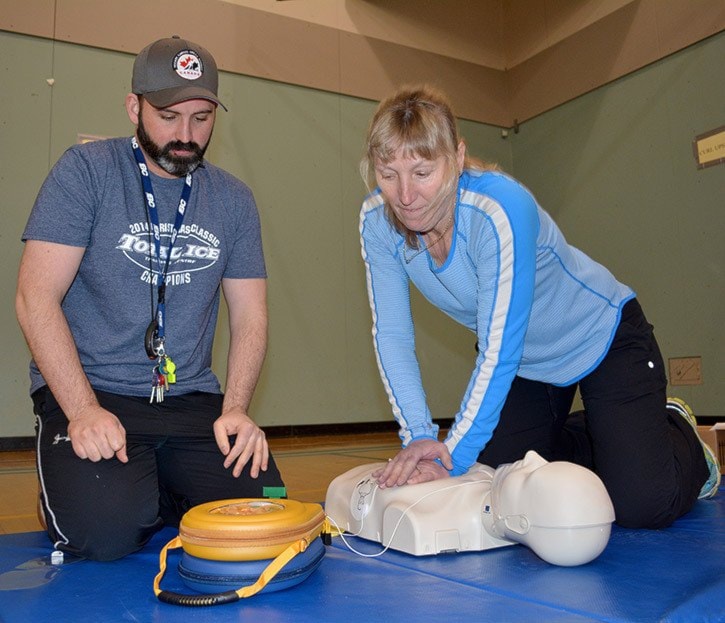Williams Lake and 100 Mile House Grade 10 students will learn how to use an Automated External Defibrillator now that six teachers in School District 27 have received training from BC Emergency Health Services to augment regular CPR training.
Last Friday four teachers from Lake City Secondary and two from Peter Skene Ogden (PSO) Secondary took an eight hour course at the Williams Lake Secondary campus with Laine Smith, an education officer with BC Emergency Health Services, BC Ambulance stationed in Prince George.
“It’s really important for students to have these skills because most cardiac arrest events occur in the home and it takes time for the ambulance to get there,” Smith said as the teachers practiced with the defibrillators. “We’ve learned that good CPR for good cardiac arrest management and timely AED are the most important thing for these patients.”
Smith has been a paramedic since 1987 and normally trains paramedics.
This is his fifth year doing the training with teachers and he loves how far reaching the training is because it then goes to students.
“You know that old Faberge commercial where it starts out with two ladies and their picture and they told two friends and how eventually the whole screen was filled up, that’s what this is to me,” he said.
Things have changed when it comes to CPR and the most important part is learning how to do it effectively, he said.
In the old days people had to measure up the chest, now they are taught to put the hand between the chest.
“It’s not the big measurement it used to be, it’s not the forced acting breaths, there’s no pulse check,” Smith explained. “If somebody isn’t breathing and they are not responding you start chest compressions.”
The teacher training has been made possible through the ACT Foundation and RBC and has resulted in the purchase of class sets of 30 Annie CPR dolls for each school that receives the training.
Williams Lake Secondary phys-ed teacher Denise Beauchamp said they’ve picked Grade 10 to be the target group.
Whether it gets taught to any other grades other than that, all Grade 10s pass through the phys-ed department because it’s still a mandatory program.
“The program is being promoted so that kids can be more up-to-date with resuscitation,” Beauchamp said. “After today we’re certified to teach our kids.”
Teacher Chris Drouillard has taught at PSO for 22 years and said the idea of the CPR training is to give kids a real life experience.
“If someone does go down at an arena or an airport they will have an idea of how the defibrillators work,” he said.
Appreciative of how the method of CPR has become less technical, Drouillard said the challenge is to teach kids that compressions two inches or more are most effective.
“It is substantial energy your pushing into a person,” he said, adding the cracking and popping sounds people hear with the deep compressions can be scary, so people are trained to know what they can expect.
He already teaches first aid awareness, avalanche awareness, and cold water survival and said the new training will be another way to teach students about saving and protecting lives.
On Friday the teachers were given new CPR mannequins and teaching defibrillators for use in the classroom.
